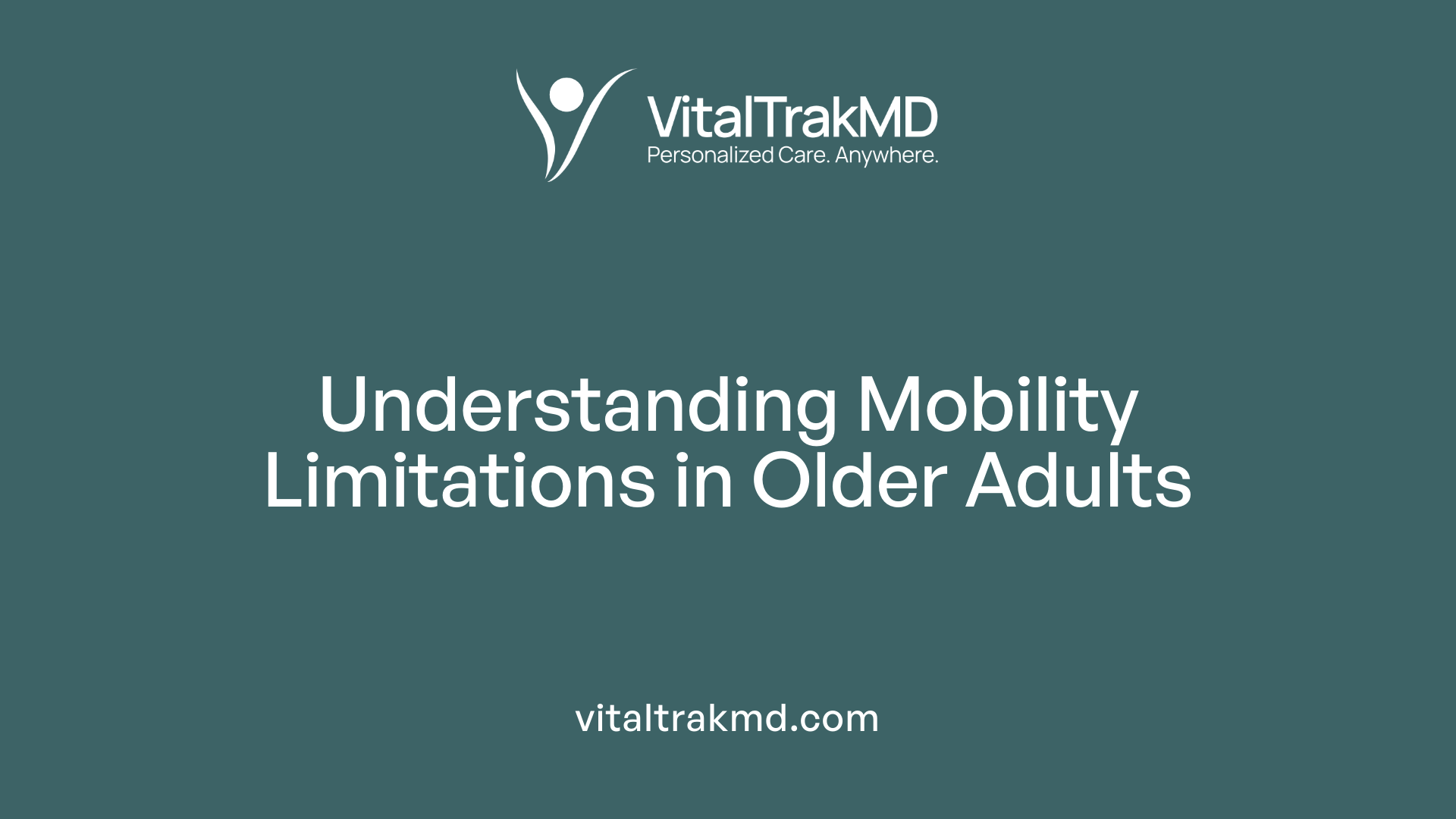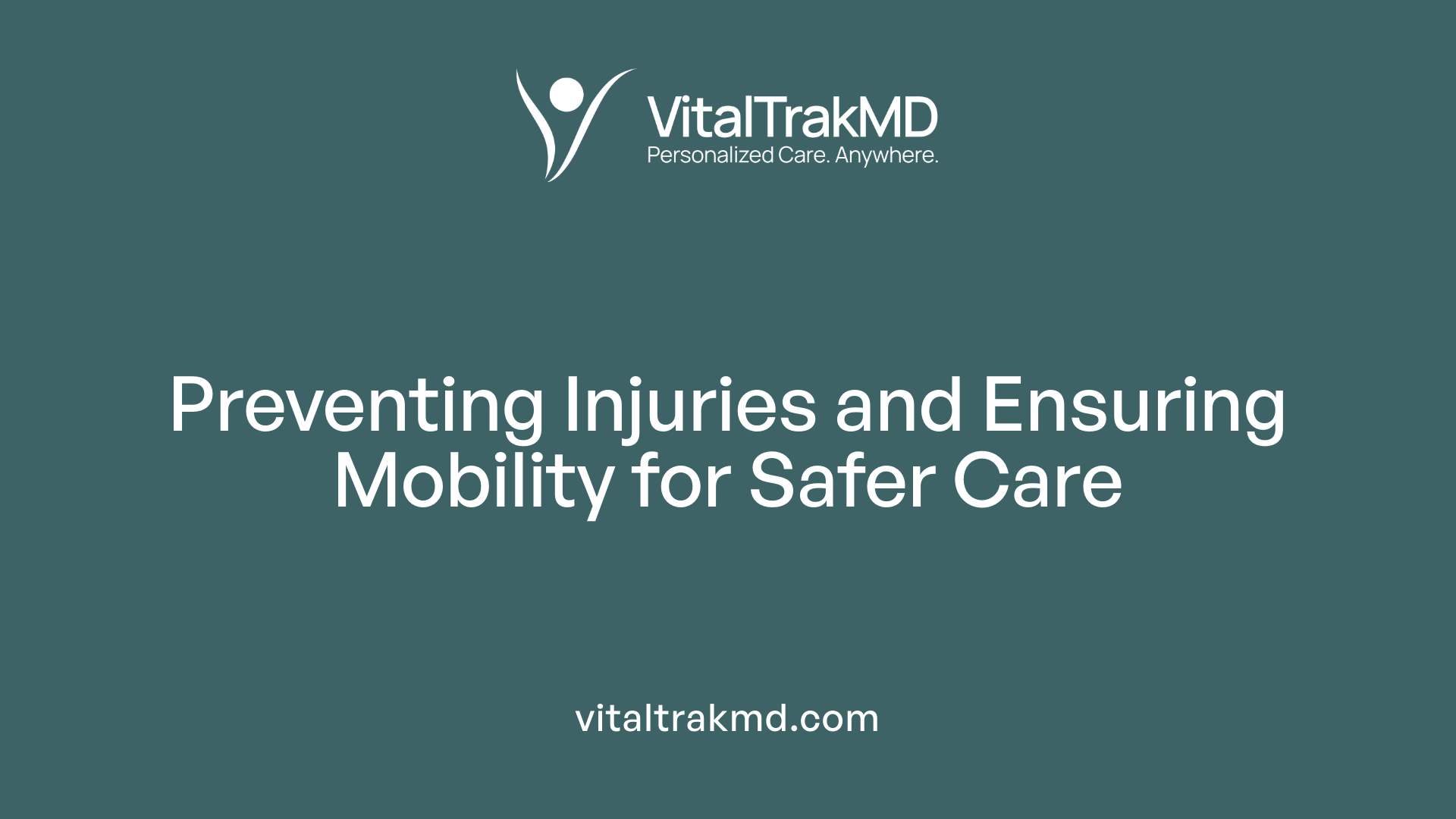How Limited Mobility Inhibits Preventive Healthcare

Understanding the Impact of Mobility Limitations on Healthcare Access
Limited mobility among older adults poses significant barriers to accessing preventive healthcare services, leading to poorer health outcomes and increased healthcare costs. This article explores how mobility restrictions hinder early detection and management of health issues, examines barriers to healthcare access, and discusses effective strategies to enhance mobility and healthcare delivery for this vulnerable population.
Prevalence and Severity of Mobility Limitations in Older Adults
 Statistics show that among older adults, mobility limitations are quite common. Research indicates that approximately 21.4% of this population experience severe mobility restrictions, 18.4% have moderate limitations, and around 60.3% report no mobility problems.
Statistics show that among older adults, mobility limitations are quite common. Research indicates that approximately 21.4% of this population experience severe mobility restrictions, 18.4% have moderate limitations, and around 60.3% report no mobility problems.
Mobility levels are typically assessed through screening questions that categorize individuals into three groups: no limitations, moderate limitations, and severe limitations. This stratification helps healthcare providers identify those who need targeted interventions to maintain or improve their movement abilities.
The impact of mobility limitations on health is significant. Older adults with greater mobility restrictions are at higher risk of experiencing falls, which can lead to injuries and further health decline. They are also less likely to participate in preventive healthcare services, have increased use of healthcare resources, and face higher medical costs.
Essentially, physical health conditions like pain and overall poor health are the strongest predictors of increased mobility issues. Addressing these factors early through interventions such as physical therapy, exercise programs, and home modifications can prevent or slow down the progression of mobility decline. This proactive approach is vital for promoting successful aging—helping older adults maintain independence, reduce fall risks, and improve overall quality of life.
Impacts of Mobility Limitations on Health Outcomes
What are the consequences of impaired mobility in older adults?
Impaired mobility significantly affects the health and well-being of older adults, leading to a series of adverse outcomes. One of the most immediate concerns is an increased risk of falls, which can result in fractures, bruises, and a fear of falling that limits activity further. Falls are the leading cause of injury among seniors, often causing hospitalizations and long-term disability.
Beyond falls, mobility limitations elevate the risk of pressure injuries, especially for those confined to bed or at risk of prolonged immobility. These injuries can complicate recovery, increase infection risks, and prolong hospital stays.
Hospitalizations are more common among those with limited mobility, not only due to falls but also because of the worsening of chronic diseases. Reduced movement impairs circulation and respiratory function, fostering the development of pressure ulcers and other complications.
Moreover, mobility decline is associated with higher mortality rates. As physical activity diminishes, so does overall resilience, making older adults more susceptible to infections, cardiovascular issues, and other life-threatening conditions.
The relationship between mobility and health extends beyond immediate injury. Fear of falling and physical inactivity often lead to social isolation and depression, further impairing mental health. Importantly, mobility limitations tend to increase healthcare utilization and costs, reflecting the broad impact of diminished movement.
Timely interventions—such as strength and balance training, assistive device use, or home modifications—can prevent or slow mobility deterioration. Promoting activities that maintain function is vital for a healthier aging process, reducing risks of severe health consequences and improving quality of life.
Barriers to Healthcare Access for Mobility-Impaired Individuals

What barriers prevent individuals with limited mobility from participating in preventive healthcare?
Older adults and individuals with limited mobility face numerous obstacles that reduce their access to essential preventive healthcare services. Physical environment barriers are among the most visible. Many healthcare facilities lack accessible features such as ramps, elevators, adjustable examination tables, or sufficient space to maneuver mobility aids. This makes visiting clinics difficult or even impossible for some.
Transportation challenges further complicate access. Public transit options may be unreliable or inaccessible for those with mobility devices. Private transportation might be unaffordable or unavailable, especially in rural or underserved areas. These difficulties often lead to missed appointments and reduced engagement with healthcare providers.
Systemic issues within the healthcare system also play a significant role. Many healthcare providers lack training or awareness about accessibility needs and best practices for treating patients with mobility limitations. This can cause discomfort, misunderstandings, or inadequate care, discouraging patients from seeking preventive services.
Financial barriers are a substantial concern. People with disabilities or mobility issues frequently face higher medical costs and may lack appropriate insurance coverage. This limits their ability to afford necessary adaptations, assistive devices, or transportation means, leading to lower uptake of preventive interventions.
Communication barriers add another layer of difficulty. Sensory impairments such as hearing or vision loss can impair understanding of health information or instructions. Language barriers and cognitive impairments may further hinder effective communication with healthcare providers.
Together, these physical, systemic, financial, and communication challenges contribute to a significant disparity in preventive healthcare utilization. Addressing these barriers through systemic reforms, infrastructure improvements, provider training, and policy changes is essential to ensure equitable access and promote healthier aging.
Strategies for Improving Healthcare Accessibility and Delivery

How can healthcare providers better deliver preventive care to individuals with mobility limitations?
Many older adults and individuals with disabilities experience mobility limitations that can hinder their access to necessary preventive healthcare services. To effectively serve this population, healthcare systems can adopt a multifaceted approach focused on environmental, technological, educational, and systemic strategies.
Environmental modifications play a crucial role in making healthcare facilities more accessible. Installing ramps, elevators, and accessible entranceways ensures that patients with mobility aids or physical impairments can reach examination rooms comfortably. Adapting medical equipment, such as height-adjustable chairs and exam tables, also facilitates care for patients with limited mobility.
The integration of telemedicine and digital health tools has opened new avenues for delivering preventive services. Virtual consultations allow patients who face transportation or physical barriers to consult with healthcare providers conveniently from home. Patient portals and mobile health apps can facilitate appointment scheduling, medication management, and health education, promoting greater autonomy.
Improving transportation options is essential. Healthcare systems can collaborate with local transit agencies to provide specialized transport services or shuttle programs that help patients reach clinics. Community-based initiatives and ride-sharing programs tailored for older adults and those with disabilities can significantly reduce access issues.
Implementing multidisciplinary mobility protocols within healthcare settings ensures a comprehensive approach to patient care. These protocols often involve collaboration among physicians, physical therapists, occupational therapists, social workers, and community health workers. Such teams develop personalized care plans that incorporate physical therapy, assistive devices, environmental adaptations, and social support.
Patient education and empowerment are critical. Education programs should inform patients about managing their mobility limitations, utilizing assistive technologies, and maintaining engagement in preventive activities like vaccination, screenings, and physical activity. Empowered patients are more likely to participate actively in their health management.
Finally, staff training on disability competency and cultural sensitivity enhances the quality of interaction and care delivery. Staff should learn to communicate effectively with individuals with various disabilities, understand their specific needs, and utilize assistive technologies appropriately. Training should emphasize respectful, person-centered care, acknowledging each patient’s preferences and autonomy.
Overall, a combination of environmental adaptations, technological innovations, systemic reforms, and educational efforts can substantially improve healthcare access and quality for individuals with mobility limitations. These strategies not only promote equitable care but also support the broader goal of helping older adults and persons with disabilities maintain independence, prevent illness, and improve their overall quality of life.
Innovative Interventions and Technologies to Enhance Mobility and Healthcare Engagement
Assistive devices and aids (wheelchairs, canes, walkers)
Assistive devices are crucial tools that help older adults improve independence and safety. Canes, walkers, crutches, and wheelchairs are commonly used to support mobility, balance, and reduce fall risk.
Proper selection and fitting of these devices are essential. Ensuring that devices are appropriately customized to individual needs, and that users receive education on their correct use, can prevent injuries and boosting confidence.
Medicare Part B covers many assistive devices, emphasizing their role in maintaining mobility. When used properly, these tools can help older adults perform daily activities like walking, transfers, and self-care more easily, ultimately enhancing their quality of life.
Effectiveness of Physical Activity and Exercise in Mobility Preservation

What are effective ways to maintain or improve mobility in older adults?
Maintaining or enhancing mobility in older adults can be achieved through consistent engagement in various physical activities. Regular exercise routines that combine aerobic, strength, balance, and flexibility training are proven to be effective.
Activities such as walking, resistance training, Tai chi, yoga, and balance exercises help preserve muscle strength, improve gait, and reduce fall risk. Adults are generally recommended to aim for at least 150 minutes of moderate-intensity exercise weekly, along with muscle-strengthening activities at least twice a week.
Environmental modifications also play a vital role. Implementing features like grab bars, ramps, and clutter-free pathways in home settings promotes safer mobility. Programs like CAPABLE, which integrate nursing, occupational therapy, and home repairs, have demonstrated success in helping older adults maintain independence.
Nutrition and pain management are additional supportive strategies. Consuming foods rich in calcium, vitamin D, and anti-inflammatory agents supports bone and muscle health. Addressing pain through physical therapy and healthcare interventions can prevent mobility deterioration.
By adopting an active lifestyle that combines these elements—exercise, environmental changes, proper nutrition, and healthcare support—older adults can sustain mobility, reduce falls, and improve overall quality of life.
Results from randomized controlled trials promoting mobility
Research backed by the National Institute on Aging shows positive outcomes from structured exercise interventions. Randomized controlled trials (RCTs) have demonstrated that participation in physical activity programs reduces the risk of major mobility disability by an average of 18% over approximately 2.6 years.
One notable trial incorporated strength training, balance exercises, and walking routines, leading to improved muscle power, better gait, and enhanced functional performance. These programs also contributed to reduced hospitalizations and delayed entry into long-term care.
RCTs underline the importance of tailored exercise protocols, emphasizing consistency and gradual progression. When combined with environmental adjustments and behavioral support, these interventions significantly support aging populations in maintaining independence.
Types of exercises: strength, balance, endurance
Effective mobility-preserving exercises encompass various types:
- Strength exercises strengthen muscles essential for daily activities, such as rising from a chair or climbing stairs.
- Balance exercises (like Tai chi or tandem stands) improve coordination and stability, reducing fall risk.
- Endurance activities (such as walking or cycling) enhance cardiovascular health and aid in weight management.
Including all these components ensures a comprehensive approach to mobility. Health professionals often design programs combining these elements based on individual abilities and needs.
Impact on reducing falls, improving muscle power, and maintaining independence
The overarching goal of physical activity is to reduce falls—a leading cause of injury among older adults—and to enhance muscle strength and balance. Studies have shown that well-structured exercise routines can lower fall incidence and increase muscle power, which in turn supports safe ambulation and daily functioning.
Moreover, sustained physical activity sustains independence, allowing older adults to perform activities of daily living independently, participate socially, and live in their preferred environments. Together, these benefits underpin the critical role of exercise in promoting healthy aging and preventing disability.
Hospitalization and Hospital-Acquired Functional Decline
What are the consequences of impaired mobility in older adults?
Impaired mobility in older adults can lead to serious health issues such as increased falls, pressure ulcers, and a significant decline in independence and quality of life. Falling and injury risk rise sharply, often resulting in hospitalizations and long-term care needs. Reduced mobility can trigger a cascade of health problems, including muscle weakening, joint stiffness, and cognitive decline, ultimately increasing mortality risk. It also contributes to greater healthcare costs due to extended hospital stays and more intensive medical interventions.
Muscle atrophy, loss of neural coordination, and psychological effects like fear of falling hinder daily activity, leading to further inactivity and health deterioration. These factors make it harder for older adults to perform routine tasks such as walking, self-care, and social participation.
Timely and targeted interventions—including strength training, balance exercises, and assistive devices—are vital for preventing or delaying mobility decline. Promoting continuous movement, even during hospital stays, can maintain physical function and foster healthier aging.
Impact of bed rest and immobility in hospitalized patients
During hospital stays, patients often spend over 95% of their time in bed, which can lead to rapid functional decline. Bed rest causes muscle wasting, joint contractures, decreased bone density, and cardiovascular deconditioning. This physical deterioration increases the risk of falls, pressure ulcers, pneumonia, and other complications. For older adults, immobility can turn into a cycle of deconditioning, making recovery more difficult upon discharge.
Hospital-induced inactivity not only impacts physical health but also affects mental well-being, increasing feelings of dependence and depression. Research shows that as little as two days of bed rest can significantly impair mobility, highlighting the need for proactive strategies.
Early mobilization strategies in hospitals
Implementing early mobilization protocols is crucial to counteract the negative effects of bed rest. These strategies involve getting patients to move and perform activities as soon as it is medically safe. Programs like IMPACT and AMP have demonstrated success in reducing hospital harms, including falls and length of stay.
Early mobilization can include supervised standing, sitting, transfers, walking, and use of assistive devices. The goal is to preserve muscle strength, improve cardiovascular health, and maintain functional independence. Interdisciplinary teams—comprising nurses, physiotherapists, and physicians—coordinate these efforts to ensure patient safety and maximize benefits.
Programs like IMPACT and AMP
Programs such as IMPACT (Incentivizing Mobility and Preventing Adverse Clinical Trends) and AMP (Accelerated Mobility Protocol) have been implemented to promote mobility during hospitalization. These initiatives focus on structured activity plans tailored to individual patient needs.
Evidence suggests that participation in these programs reduces fall risk, shortens hospital stays, and improves post-discharge mobility outcomes. They emphasize early assessment, prompt intervention, and continuous monitoring.
Effects of COVID-19 on mobility in care settings
The COVID-19 pandemic led to increased restrictions and isolation measures in healthcare settings, resulting in heightened immobility among hospitalized and long-term care patients. Reduced staff contact, visitor restrictions, and infection control protocols limited opportunities for movement.
Consequently, many older adults experienced deterioration in functional abilities, with some unable to participate in rehabilitation activities. These effects underscore the importance of integrating mobility promotion even amidst pandemic-related challenges.
Risks associated with prolonged hospital stays
Extended hospitalization correlates with heightened risks of functional decline, hospital-acquired infections, and psychological distress. Longer stays compound the effects of immobility, leading to more frequent and severe losses in mobility.
Reducing hospital stay length through effective early mobilization not only helps preserve physical function but also decreases healthcare costs and improves patient satisfaction.
| Topic | Details | Additional Notes |
|---|---|---|
| Consequences of impaired mobility | Increased falls, pressure ulcers, lengthier hospital stays, higher mortality | Critical to implement timely interventions |
| Impact of bed rest | Muscle atrophy, joint issues, cardiovascular decline | As little as two days can cause decline |
| Early mobilization | Standing, walking, rehab activities | Promotes recovery and reduces complications |
| Programs like IMPACT and AMP | Structured activity protocols | Proven to shorten stays and improve outcomes |
| COVID-19 effects | Increased immobility, reduced rehab | Highlights need for adaptable mobility strategies |
| Risks of prolonged stays | Functional decline, infections | Accelerating early mobilization is essential |
Role of Healthcare Personnel and Injury Prevention

How do mobility issues relate to healthcare utilization and health risks such as falls and pressure injuries?
Limited mobility in older adults is closely linked to higher use of healthcare services. When mobility declines, the risk of falls increases significantly, often resulting in fractures, bruises, and head injuries. These falls are the leading cause of injury among seniors and frequently lead to hospitalizations and long-term care needs.
During hospital stays, especially with prolonged bed rest, patients face a greater chance of developing pressure injuries (pressure ulcers). Immobility reduces blood flow to the skin and underlying tissues, causing pressure ulcers that can become infected and complicate recovery.
Mobility impairments also hinder individuals from accessing preventive health services, such as screenings and vaccinations. This reduces management of chronic conditions like diabetes and cardiovascular disease, worsening health outcomes.
Barriers like difficult-to-navigate environments and transportation problems further limit healthcare access, particularly for those in rural areas. As a result, untreated health issues worsen, leading to increased hospital readmissions and healthcare costs.
In essence, mobility problems not only heighten risks for falls and pressure injuries but also contribute to greater healthcare utilization overall. Addressing mobility issues is therefore crucial for reducing preventable injuries and optimizing health management.
Musculoskeletal disorders in healthcare workers
Healthcare workers, including nurses and aides, frequently experience musculoskeletal disorders (MSDs) due to manual patient handling, such as lifting, repositioning, and moving patients. About 41 cases per 10,000 healthcare workers result in lost workdays, with nurses reporting particularly high rates of back and shoulder injuries.
Injuries due to manual handling and patient repositioning
Manual handling activities are the primary cause of work-related injuries among healthcare staff. These tasks often involve awkward postures and forceful exertion, which increase the risk of strains and sprains. Repeated injuries can cause chronic pain, disability, and workforce shortages.
Safe patient handling and mobility (SPHM) programs
SPHM programs are designed to reduce caregiver injuries through the use of specialized equipment, training, and protocols. These initiatives have demonstrated a 56% reduction in caregiver injuries and a payback period of about 15 months by decreasing equipment costs. Additionally, they improve patient outcomes by facilitating safer transfers, reducing falls, and lowering hospital stay durations.
Impact of caregiver injuries on workforce sustainability
Injuries and chronic pain lead many healthcare workers to change roles, consider transferring, or leave the profession altogether. Data shows that 32% of staff with back pain have altered their roles, and 12% have left due to injury. With projected workforce shortages, these injuries threaten the sustainability of healthcare systems.
Strategies to reduce injuries and improve patient safety
Incorporating advanced lifting devices, staff training, and ergonomic practices can significantly cut injury rates. Regular assessment of staff needs and investments in equipment support safe handling. Implementing these strategies not only preserves workforce health but also enhances patient safety by minimizing movement-related accidents.
In conclusion, both patient and caregiver mobility are intertwined aspects that impact health outcomes and healthcare safety. Effective injury prevention in healthcare settings is essential to maintain a healthy workforce and provide optimal patient care.
Moving Forward: Overcoming Barriers and Promoting Mobility
Addressing the multifaceted challenges related to mobility limitations in older adults requires a collaborative effort involving healthcare providers, policymakers, communities, and patients. Improving physical infrastructure, expanding access through technology, enhancing provider training, and implementing personalized interventions are essential to remove barriers and promote sustained mobility. Emphasizing early intervention, leveraging assistive technologies, and fostering accessible environments can significantly improve preventive healthcare engagement and health outcomes. By prioritizing mobility in aging populations, we can reduce risks of falls and injuries, diminish healthcare costs, and enhance quality of life, ensuring that older adults can age with independence, dignity, and vitality.
References
- The impact of mobility limitations on health outcomes among older ...
- Maintaining mobility and preventing disability are key to living ...
- The Tension Between Promoting Mobility and Preventing Falls in the ...
- Challenges and opportunity in mobility among older adults
- Common Causes of Limited Mobility and Prevention Tips
- Health and Wellbeing Care: How Mobility Impacts Quality of Life
- Association of Mobility Limitations With Health Care Satisfaction and ...
- Caregiver Guide: Mobility Problems | HealthInAging.org
- qualitative study of factors that inhibit and promote preventive care ...
Recent articles
Want to Feel Better and Live Healthier?
Join hundreds of patients taking control of their health with personalized care that fits their life – not the other way around.
Rated 4.8/5 by 32+ customers







